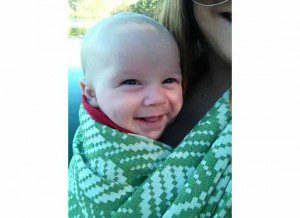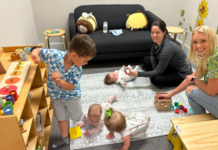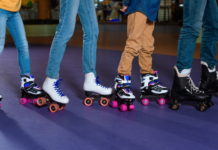 I admit it: “babywearing” is a ridiculous term. You can thank Dr. Sears for the awkward portmanteau, which basically means “strapping your kid to yourself so you have free hands,” but makes your baby sound like a trendy pair of jeans.
I admit it: “babywearing” is a ridiculous term. You can thank Dr. Sears for the awkward portmanteau, which basically means “strapping your kid to yourself so you have free hands,” but makes your baby sound like a trendy pair of jeans.
And babywearing is nothing if not trendy. Tabloids regularly publish pictures of stars with infants tied to their chests. Mainstream stores have moved beyond the Bjorn, into a bewildering array of wraps and slings and pouches and “sport” carriers and something called a mei tai (which sounds like an Asian drink special or a local Thai place).
And it’s not just the hippies anymore. That guy you saw in Target with a baby strapped to his chest? He didn’t look like a joke from The Hangover. Baby carriers are the latest registry must-have. Should you jump on the bandwagon?
They say there’s nothing new under the sun, and whoever “they” may be, they’re probably right. Some scientists suggest babywearing was a significant factor in human evolution, and even today, in many cultures, babywearing remains the norm. Research suggests there’s more benefits to babywearing than just free hands, too. Even in our modern world, there’s lots babywearing can do for moms – and babies.
There are a few things we all can agree on. We love our kids. We want to poop alone. And we want our kids to cry as little as possible. Anthropologists have always suggested that babies cry less in cultures where infants are constantly carried. But in 1987, a team of researchers in Montreal proved that babies who are worn do, in fact, cry less – a lot less. Three hours of babywearing a day reduces infant crying by a whopping 48%. That’s almost half as many tears, and a whole lot less stress.

And less stress on baby means less stress on mamas. Babywearing reduces postpartum depression in two different ways:
First, the skin-to-skin contact with baby increases levels of mama’s oxytocin (known as the “feel-good hormone”). It’s long known that human touch raises mood and protects against depression; babywearing makes cuddling easy (and sort of irresistible; you can nibble and kiss newborn baby head all day).
But babywearing also helps new parents feel more confident. They can return to their normal routines more quickly and easily. They can go out in public. Babywearing remains the only way I can manage makeup while parenting children under two (so if my eyeliner ever looks funky, well, now you know why. A tiny human was wiggling and batting at me).
That confidence doesn’t just come from easier social interaction for mama (another protective factor for depression). It also comes from easier social interaction with her baby. The close physical proximity helps parents learn baby’s cues for hunger, sleep, and diaper changes. Every time we meet baby’s needs successfully, we feel better. Babywearing International calls it a “cycle of positive interaction.”
Meeting baby’s physical needs makes him feel more secure. There’s a growing body of research to suggest that secure attachment in infancy forms the foundation of psychological health in adulthood. That same research suggests that babywearing promotes security, not just by meeting baby’s need for touch or food quickly, but by helping mothers become more sensitive to their children’s emotional needs.
Babywearing helps mama and baby “tune in” to each other more readily. That tuning in isn’t limited to mamas, either. Because baby’s at the height of adults’ faces, he learns social cues earlier and more quickly. Dr. Sears calls it “humanizing,” and suggests it’s an important advantage to babywearing.
And once we get into “humanizing” we start to reach that mushiness of “things we suspect but don’t know for sure, and probably sound insane to people who haven’t already drunk the Kool-Aid.” Emotional advantages are particularly hard to measure. But physical advantages aren’t, and babywearing has proven to reduce rates of illness. Babies treated with kangaroo care – being worn upright, skin-to-skin – go home from the NICU quicker, suffer less infections, and regulate their body temperature better. They breath better and sleep better. They gain weight quicker. Basically: kangaroo care seriously improves babies’ outcomes.
So yes, babywearing helps mamas and babies feel better both emotionally and physically. It helps them feel closer. It makes their lives easier. But the biggest benefit for many of us? Free hands. You can cook dinner, or chase your toddler, or do the dishes. You can carry bags. You can go to Target without hauling an infant carrier.

And while we’re on the subject of infant carriers, it’s important to note that the American Academy of Pediatrics recommends confining their use to the car. The position they hold children in causes oxygen desaturation – i.e., baby’s brain gets less oxygen when he’s in a carseat. We’ve known for a long time that this is a risk for preemies, and NICU babes are usually tested for oxygen desaturation in a carseat position before discharge. But now we know that it’s a risk for term infants, too. Babywearing can give you an alternative to hauling around that bulky seat – and possibly risking baby’s health.
Babywearing’s trendy right now. But it’s a trend for a good reason. Even a little bit of wearing can help make baby and mama’s life easier. So yes, you probably ought to jump on the bandwagon. You might not look as hot as Gisele in her Ergo, but your baby will be just as happy. Promise.
Luckily, Columbia SC Moms Blog is here to help you. Now that you want to wear your baby, you need help knowing how. In the upcoming posts in our Babywearing series, we’ll let you know some great local outdoor places to wear your baby, as well as help you understand your carrier options (and let you know where to buy them locally). Happy wearing!
For immediate babywearing help, we have two babywearing groups in the area: Babywearing International of Columbia, SC (www.facebook.com/groups/BWIofColumbia, or www.columbiabwi.blogspot.com) or Babywearers of the Midlands (www.babywearingsc.org).














